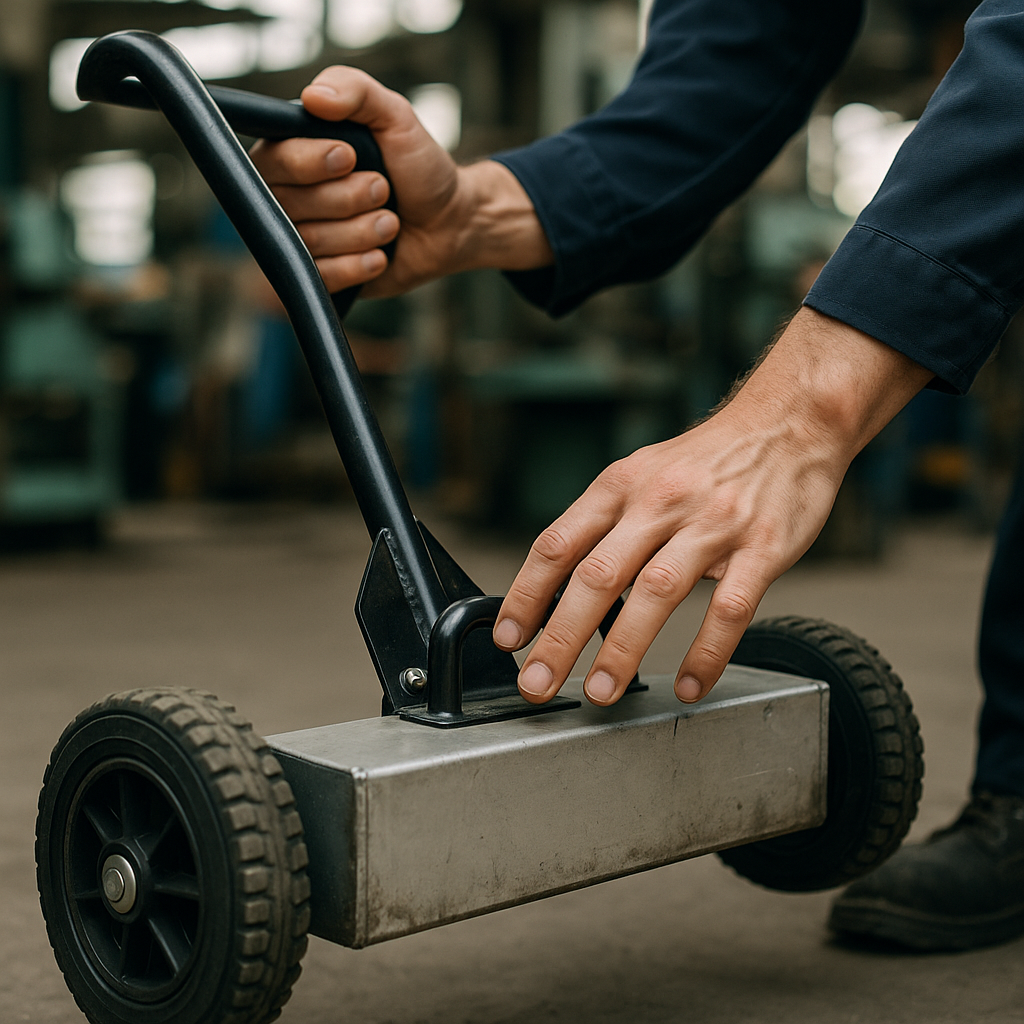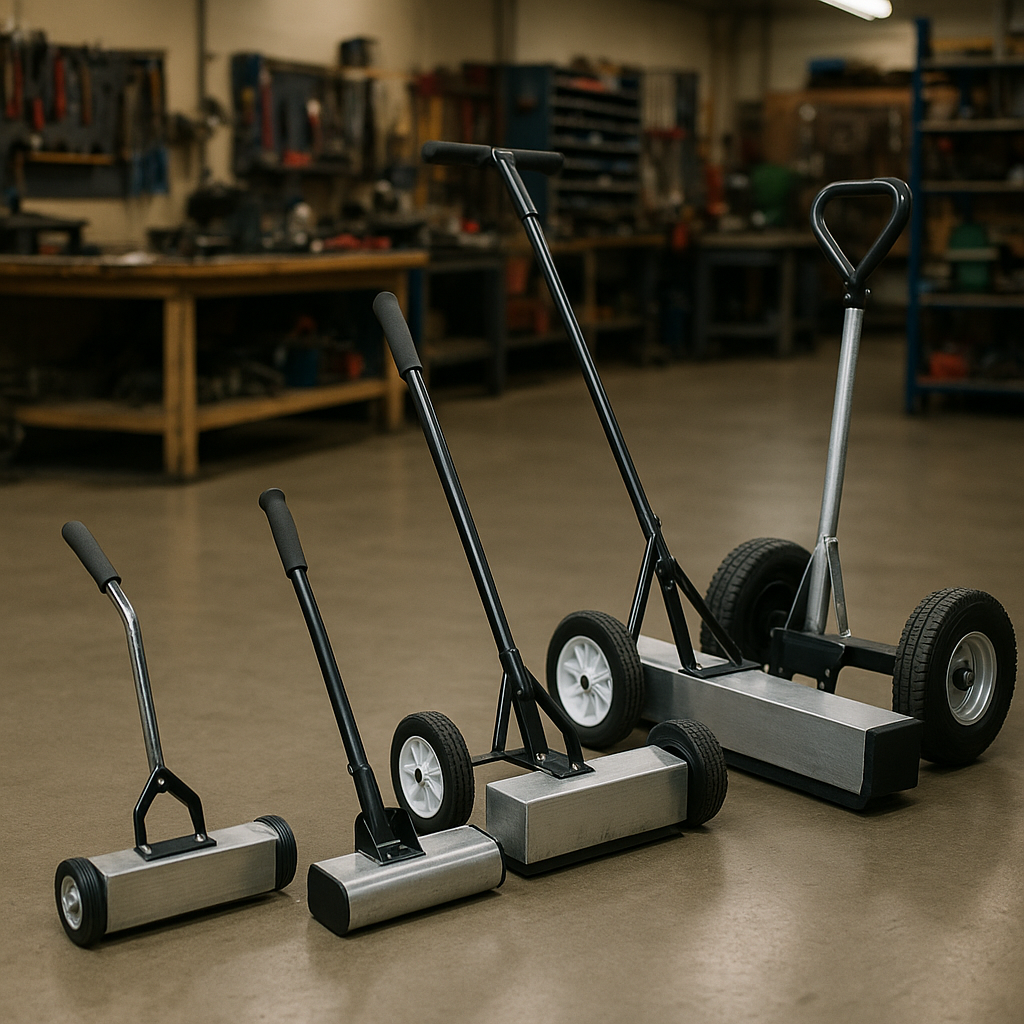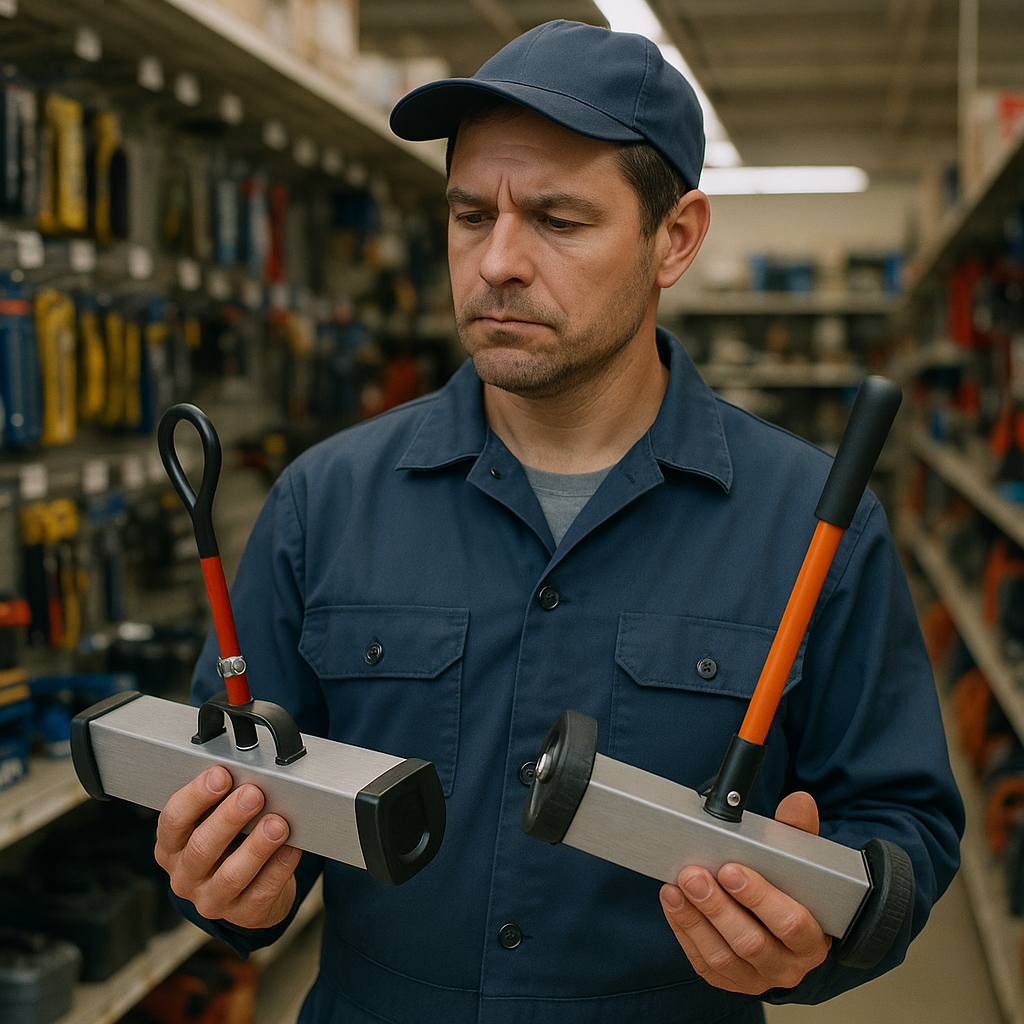5901 Botham Jean Blvd, Dallas, TX 75215
Magnetic Sweeper: Its Importance, Features, and Types
July 25, 2025Have you ever walked across a workshop floor only to find a sharp nail stuck in your boot? Or perhaps you’ve experienced the frustration of a flat tire caused by metal debris in a parking lot. Magnetic sweepers solve these common problems with a simple yet ingenious design.
A magnetic sweeper is a practical tool designed to collect ferrous metal debris from various surfaces quickly and efficiently. Using powerful magnets with strong magnetic fields, these devices attract and hold items like nails, screws, bolts, washers, and metal shavings that would otherwise remain hazardous to people, vehicles, and equipment.
Unlike traditional cleaning methods that might miss small metal objects, magnetic sweepers specifically target ferrous materials. They come in various configurations to suit different environments – from compact handheld units for small workshops to large tow-behind models for extensive outdoor areas like construction sites, parking lots, and industrial facilities.
Why Is Metal Debris Removal So Important?

Metal debris on the ground poses serious risks to both people and equipment. In industrial environments, manufacturing facilities, and construction zones, stray nails, screws, or wire fragments can easily puncture tires, damage machinery, and cause injuries. Even in public spaces like parking lots or parks, metal fragments threaten pedestrian safety and create liabilities for property owners.
Aside from physical hazards, metal debris also contributes to operational inefficiencies. Downtime from tire repairs, machinery damage, or injury investigations can disrupt workflows and increase maintenance costs. In some industries, stray ferrous metals can even interfere with production processes, especially in facilities where clean environments are critical.
Regular use of magnetic sweepers not only improves workplace safety but also extends the lifespan of tools, vehicles, and flooring. It supports OSHA compliance in high-risk zones and helps maintain clean, professional facilities. Whether you’re managing a warehouse, overseeing a job site, or maintaining a public venue, proactive metal debris removal is essential for operational success and safety assurance.
What Features Should You Look For in a Magnetic Sweeper?

When evaluating magnetic sweepers for purchase, it’s important to look beyond the basic design and consider key features that directly impact performance and usability. One of the most critical features is magnetic strength. Higher-grade magnets—especially neodymium—offer superior pickup power for collecting deeply embedded or heavier metal fragments. Choose a sweeper with sufficient magnetic force to handle your typical debris load.
Another important feature is the release mechanism. A quick-release system allows users to safely and easily drop collected debris into designated containers without manually handling sharp objects. This feature not only speeds up the cleanup process but also reduces injury risk.
Adjustable height settings are essential, especially for surfaces with uneven terrain. Being able to fine-tune the clearance between the magnet and the ground ensures optimal pickup without scraping or missing debris. Durability also matters—look for models with rugged wheels, corrosion-resistant housings, and strong frame construction suitable for repeated industrial use.
Additional enhancements may include telescoping handles for ergonomic comfort, weatherproof construction for outdoor applications, and modular mounting options for increased versatility. The right mix of features ensures your magnetic sweeper meets the specific demands of your work environment and provides consistent, long-term value.
What Are the Different Types of Magnetic Sweepers?

Magnetic sweepers come in several distinct types, each engineered for specific environments and debris collection needs. Understanding the differences helps you select the right tool for maintaining clean, safe spaces free of potentially hazardous metal debris.
- Push-Type Magnetic Sweepers: These manually operated sweepers function similarly to traditional brooms but with powerful magnetic capability. Ideal for workshops, garages, and smaller indoor areas, they offer precise control for thorough cleaning of confined spaces. Available in various widths, they allow users to choose the size that best fits their workspace.
- Tow-Behind Magnetic Sweepers: Designed to attach to vehicles, these sweepers efficiently cover expansive areas like parking lots, airfields, and construction sites. They can be pulled at speeds up to 15 mph, making them perfect for large-scale metal debris collection over vast stretches of ground. Some models feature puncture-proof tires for reliable performance in challenging conditions.
- Hang-Type Magnetic Sweepers: These models mount on the front of vehicles such as trucks and forklifts. Popular in industrial settings and construction sites, they allow for efficient cleaning while performing other tasks. Their design enables operators to sweep areas without leaving their vehicles, increasing productivity.
- Magnet Rollers: These compact magnetic sweepers roll across surfaces to collect metal debris. Their smaller size makes them exceptionally maneuverable in tight spaces where larger sweepers cannot reach, making them valuable for detailed cleanup work in confined areas.
- Multi-Configuration Sweepers: Versatile models like the VersaSWEEP offer 4-in-1 functionality, allowing use as push, tow, hang, or forklift-mounted tools. This adaptability makes them cost-effective for operations that require different sweeping approaches in various environments.
Each type offers specific advantages depending on the application. For small indoor areas, push-type sweepers provide precision. Large outdoor spaces benefit from tow-behind models’ coverage capabilities. Industrial facilities often prefer hang-type sweepers for their integration with existing equipment. Tight spaces call for compact magnet rollers, while operations with diverse needs might select multi-configuration systems.
The effectiveness of any magnetic sweeper depends on matching its design to your specific requirements. Consider factors like the size of the area to be cleaned, the type of surface, and whether you need vehicular assistance when selecting the appropriate magnetic sweeper for your needs.
Most magnetic sweepers feature a quick-release mechanism that allows for easy disposal of collected metal debris. This function prevents the need for manual removal of magnetic materials, saving time and improving safety during the cleaning process.
How Do You Use a Magnetic Sweeper?
Using a magnetic sweeper effectively requires proper technique and understanding of the tool’s capabilities. The right approach ensures maximum debris collection while extending the life of your sweeper.
Select the Appropriate Sweeper Type
Begin by choosing the right magnetic sweeper for your specific needs. Consider the area size, surface type, and the kind of metal debris you expect to collect.
For small workshops or garages, a handheld or push-type sweeper works well. Larger areas like parking lots or construction sites may require tow-behind or vehicle-mounted options.
The sweeper width should match your workspace. Narrower sweepers work best for tight spaces, while wider models cover more ground quickly in open areas.
Inspect the Area Before Sweeping
Before using your magnetic sweeper, thoroughly scan the area for obstacles or hazards that might interfere with operation. Remove any large objects that could damage the sweeper or prevent proper contact with the surface.
Check for non-ferrous debris that won’t be picked up by the magnet. Magnetic sweepers only collect ferrous materials like iron and steel, not aluminum, copper, or stainless steel.
Clear the path of any potential obstructions to ensure smooth movement across the surface. This preparation step saves time and prevents sweeper damage.
Adjust Height and Positioning
For optimal performance, adjust the height of your magnetic sweeper. Push-type or hang-type sweepers often have height adjustment features that allow you to set the perfect distance between the magnet and the surface.
The ideal height keeps the magnetic surface close enough to attract metal objects without dragging or scraping against the ground. For most applications, maintaining a consistent 1-2 inch clearance works well.
If using a tow-behind sweeper, securely attach it to your vehicle following the manufacturer’s instructions. Double-check all mounting points before beginning operation.
Use Proper Sweeping Technique
Move the sweeper systematically across the area using a methodical approach. For push-type sweepers, use slow, overlapping passes similar to mowing a lawn. This ensures complete coverage without missing sections.
Maintain a consistent pace while sweeping. Moving too quickly may cause the magnet to miss smaller objects, while moving too slowly isn’t necessary and wastes time.
For vehicle-towed sweepers, drive at a steady, slow speed. Most manufacturers recommend 5-10 mph maximum for effective debris collection.
Empty Collected Debris Regularly
Check your sweeper periodically during use to assess debris accumulation. When significant material has collected, empty it into a suitable container or designated area.
Most modern magnetic sweepers feature a quick-release mechanism. Pull the release handle to shift the magnet away from the housing, allowing collected items to drop off. This process typically takes less than ten seconds.
For sweepers without a release mechanism, use a glove or shop towel to manually remove debris from the magnetic surface. Never use bare hands, as sharp objects could cause injury.
Clean and Store Properly After Use
Once your sweeping task is complete, thoroughly clean the sweeper by removing any remaining debris from the magnetic surface. This prevents corrosion and maintains magnetic strength.
Inspect the sweeper for signs of wear or damage. Check wheels, handles, and mounting hardware for any issues that might need attention before the next use.
Store your magnetic sweeper in a dry location away from extreme temperatures. Keep it elevated off the ground if possible, and position it where it won’t be damaged by other equipment.
Follow Essential Safety Precautions
Always wear appropriate personal protective equipment when using a magnetic sweeper. Gloves protect your hands from sharp collected objects, while safety glasses shield your eyes from potential debris.
Keep electronic devices and magnetic media away from your sweeper. Strong magnets can damage smartphones, computers, credit cards, and other sensitive electronics.
If using a tow-behind sweeper, ensure all personnel maintain a safe distance from the moving vehicle. Establish clear communication protocols between the driver and ground workers.
Conclusion: Choosing the Right Magnetic Sweeper

Magnetic sweepers serve as vital tools across diverse settings where metal debris poses safety risks. From push-type models ideal for workshops to heavy-duty hanging varieties for industrial environments, each sweeper type offers specific advantages based on your needs. The key to selecting the right magnetic sweeper lies in evaluating factors such as magnetic strength, sweeper width, and the specific environment where you’ll use it.
When choosing a magnetic sweeper, consider the type of surface you’ll be cleaning, the volume of metal debris you typically encounter, and how frequently you need to perform cleanup operations. Push sweepers work well for smaller areas while tow-behind or hanging sweepers excel in larger industrial settings. Your investment in the right magnetic sweeper will yield significant returns through enhanced workplace safety, reduced equipment damage, and more efficient cleaning operations. For professional advice on selecting the right recycling and waste management solutions for your metal debris needs, contact Okon Recycling at 214-717-4083.
